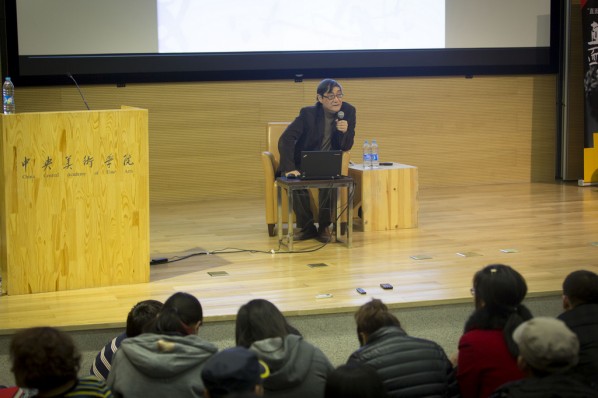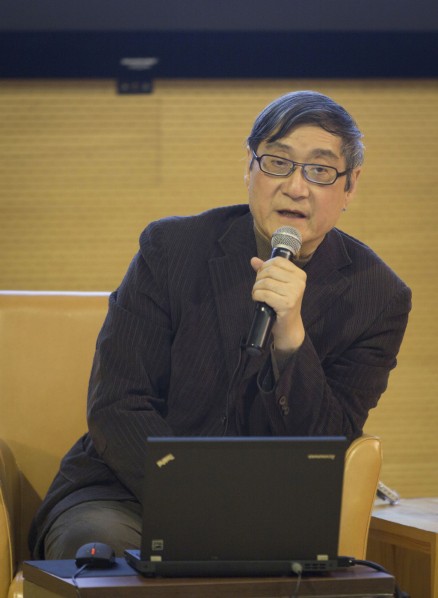
Pan Gongkai, President of CAFA, gave a lecture on “The Boundary and End of Art” at the Auditorium of CAFA Art Museum at 18:30 on November 12, 2013. The lecture was hosted by the CAFA Student Union, organized by the Department of Study and Practice at the Student Union, and was the fourth session of the “Facing Outstanding Teacher Series - Dean Forum” of the series of activities to celebrate the 95th anniversary of the establishment of CAFA.
The position of the issue of the boundary in the art studies of the 20th century
“The boundary and end of art” is the central topic of the 20th centurial mainstream art and fine art circles, President Pan talked about the “Spring” created by Duchamp in 1917 and “Brillo Boxes” created by Andy Warhol in 1964. These two works aroused the attention and discussion of the well-known American art philosopher and aesthetic Arthur Coleman Danto. In the books “The End of Art” and “After the End of Art”, Arthur successively pointed out that Duchamp put forward the issues of “What is art” and “Why is it art when it isn’t like itself”. Andy Warhol’s “Brillo Boxes” raised a profound philosophical issue “Why are they artworks, although there’s difference between Andy Warhol’s boxes and commercial boxes, it is obvious that it can’t interpret the difference between art and reality.”
In the opinion of Arthur Danto, the appearance of “Spring” by Duchamp and “Brillo Boxes” by Andy Warhol, broke the boundary of art, because the boundary between art and life was blurring, Danto believed that “art ends”. Then what should we do after the end of art? Arthur Danto proposed “Beauty in the third field”: in thinking and philosophy – directly serves life. However, Danto had never explained “what is the beauty in the third field” in detail. German art historian Hans Belting also raised an issue in the book “The End of the History of Art” in 1987.

“On the Boundary of the Western Modern Art”
Pan Gongkai completed a thesis “On the Boundary of the Western Modern Art” when he was a visiting professor at the American Berkeley College from 1992 to 1994. He proposed a theory of “Fault Structure” precisely answering the issues of “Difference between Art and Reality” by Arthur Danto and “The End of the History of Art” by Hans Belting.
“Fault Structure” refers to the fault structure, placement and sequence produced by the non-logical relationships between the internal structure of things or humans and the surrounding environment, which is a fault structure in time and space. Pan Gongkai thought that the difference between art and reality was: fault structure and alienation. Artworks are an abnormal constitution, a non-logical structure, which was a fault structure; People lived in the normal logical nets, but the “idea” (artworks must be given a special non-practical intention by the artist) of artists was an abnormal intention, this made artworks break off and isolated from the logic nets. Pan eventually concluded the definition of art: Artworks are an abnormal form of life, and the essential conditions were: fault structure of the form+ the isolation of meaning.
Pan Gongkai offered a conclusion in the book “On the Boundary of the Western Modern Art”: Art had never become life, while life had never become art. In Western history there were two parallel rivers: the first one was the road for the survival and development of human beings based on basic life requirements, namely, the history of clinging to normal life – this was the history of human life, which was the social history; another one was that humans were intent to get rid of the normal state of life, to search for spiritual freedom and be beyond history – this was the history of humans distant from life, which was the history of art. They mutually complemented and co-existed, never giving up; never confusing, and are quite distinct from each other.

“Conversion of thought” of aesthetic narration in the Chinese context
At the end of the lecture, Pan also pointed out another hidden narration – aesthetic narration in the Chinese context, in the book “On the Boundary of the Western Modern Art”. In the Western context, art research focused on “beauty”, while the center of Chinese art research was “aesthetic”. “Beauty” was in the field of “objectification”, thinking highly of material works; “aesthetic” was in the field of subjectification, focusing on the process of understanding. Therefore, Pan Gongkai put forward, that the Western context focused on viewing the normal state with the use of the abnormal state, namely “fault structure”; while the Chinese context focused on viewing the normal state with the use of abnormal state, namely “Conversion of thought”, which was like Zen. In the end, Pan took his works “This is My Work” as an example to explain it.
Journalist: Ye Yuanfeng, Photography: Hu Zhiheng/CAFA ART INFO
Translated by Chen Peihua and edited by Sue/CAFA ART INFO




























